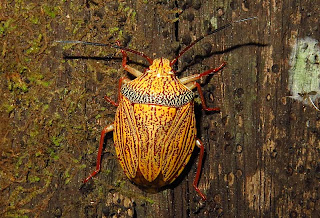I’ve been
seeing a lot and taking a ton of photos over the past few weeks, just no time
to blog about it – or simply because I’ve been in such wonderful places that
there is no internet. After Brazil was a terrific SE Peru tour (the Kosñipata
Valley and Manu National Park), and now I’m back in Brazil, this time in the SE
states of Rio de Janeiro and São Paulo, scouting for a new tour. I now have
enough material for a daily blog for the next 5 years, and I was wisely told
recently that I’ll never really “catch up.” I can only try to not fall too far
behind.
I had sorted
out this nice batch of photos quite a while back, just waiting for a simple
intro, and now these things seem like ancient history to me. Many of the
following were found at the footpath lights at Cristalino Jungle Lodge – the
rather dim energy-saving fluorescent-like bulbs that light the pathways from
the bungalows to the boat dock and to the new restaurant.
This
megalopteran (yes, that’s a real name of an order) is a dobsonfly, I’m guessing
a female with those tiny jaws.
I’d only
ever seen the adults (even at lights in the US, where there are nearly 20
species), but I now have a photo of an Andean Motmot at Machu Picchu with a
critter in its bill that might very well be a dobsonfly larva. A blog soon to
come?
I don’t have
a name for this gorgeous pentatomid, other than perhaps one I make up. How
about Grizzled Yolk Stinkbug?
I had seen
this fulgorid at Cristalino before, but I didn’t know that you can grab them
(they can’t bite) and see some fascinating colors and patterns on the hindwings
and abdomen. This is one is Diareusa
annularis.
This
gorgeous arctiine tiger moth is Rhipha
flammans, for which there are very few online photos.
This moth is
Perola villosipes, family
Limacodidae. It has a truly bizarre way of holding its forelegs up in the air for
one, but look at all those pseudoscorpions! This is quite possibly the first
online photo of a limacodid moth with phoretic pseudoscorpions. I have seen
this at Cristalino before, but with a saturniid moth, and it’s a well-known
phenomenon with beetles.
Here’s one
cropped down. Not a disease, and probably not weighty enough to bother the
moth, these guys are just hitching a ride to the next flower or tree, or
wherever it is this moth goes when it’s not confused by bright lights. It’s a
thing called phoresis, kind of like the mobile insect version of an epiphyte
(which is a non-mobile plant version of a phoretic arthropod).
We also took
a couple night walks away from the lit paths, one to the riverside rocks to
look at fish. We may have seen
20-plus species of fish, but they are very difficult to get photos of at night,
and many of the species are proably not even identifiable; I did manage this
crab.
On the trail
into the forest, we came across this Leptodactylus
mystaceus, Basin White-lipped Frog.
Looking like
a cross between a spider and a crab, this is what in the US we call a daddy
longlegs, perhaps more appropriately a harvestman. Ours are in a different
family though, this one is in Gonyleptidae, and perhaps an expert might know
which species it is.
This lovely
longhorned beetle is Taeniotes scalatus.
Now to
things that sting. These are hunting ants in the subfamily Ponerinae, and one
thing they share with the famous Bullet Ant (subfamily Paraponerinae) is their
ability to sting (not just bite). I’ve never experienced it, but one of the
participants in the trail behind me yelped and conferred that they “pack quite
a belt.”
Luckily we
all avoided getting stung by this Tityus
sp. scorpion. Some species in the genus are of medical interest (i.e. quite
dangerous), and this might be one of them. I actually spotted it using my
little hand-held UV light that I got for Christmas a couple years ago. It
really works!



















Awesome!!
ReplyDeleteHow about Paradise Stinkbug?
ReplyDeleteHello, Richard!
ReplyDeleteMy name is Walther Ishikawa, from São Paulo, Brazil.
I am part of the team of a Brazilian website about freshwater invertebrates, this one:
www.planetainvertebrados.com.br/
The crab is a "Fredius reflexifrons". We are writing a small article about this species, and I was interested in using your picture in our website. If you agree, it will be an all non-commercial use, it will be credited, with acknowledgments, and all the copyright will still be yours.
Besides the article, it is a very interesting picture, because there is not any specimen of this species in Mato Grosso state, only a couple of female or juvenile crabs in museuns. In the majority of distributional maps of this crab, it is restricted to a northern distribution in Amazon basin. In that sense, your picture is a "proof" that Pseudotheuphusid crabs can be found in such a southern limit.
I sent my personal e-mail adress in your Flickr mail, please, take a look.
Thank you for your attention!
All the best,
Walther Ishikawa